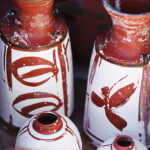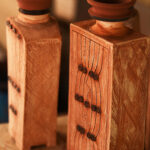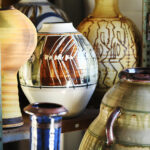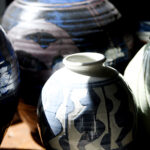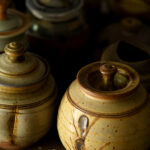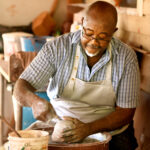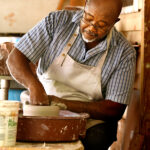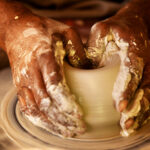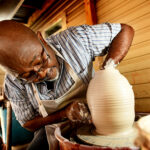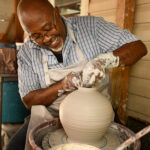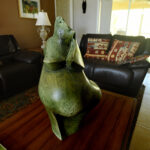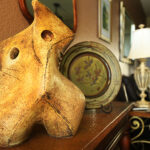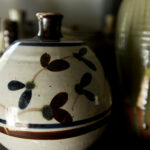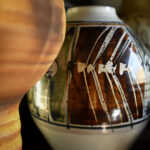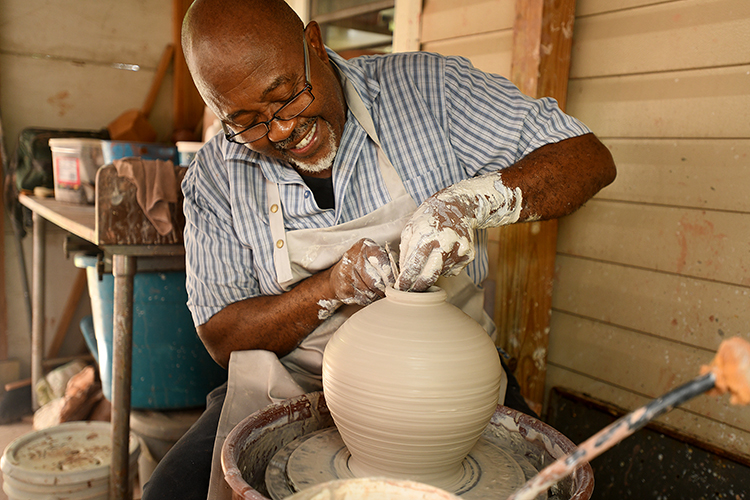
Walford Campbell is a master potter and sculptor in clay whose works speak to his command of materials and form. From ordinary kitchen wares, such as mugs, plates and platters of terracotta clay decorated with colorful majolica glazes, to decorative wares, vases and vessels of porcelain, and stoneware of classic shapes and earthy color, Campbell’s wheel-thrown production is linked to antiquity, while still managing to look of the moment.
And then there are his sculptures, not thrown on the wheel, but hand-built in the time-honored coil tradition. The human body, as well as found stones shaped by tide and time, are major inspirations for his fine art pieces.
Says Campbell, “I love the female form.”
His work is continuously represented at Gallery 14 in Vero Beach. Earlier this year the gallery featured his works along with those of three other artists. In that show a trio of his sculptures, “Cotton Bag,” “Rust” and “Sand by the Sea,” commanded a central position in the exhibition space.
Currently, Campbell is readying pieces for his booth at the upcoming Under the Oaks Fine Art and Craft Show March 12-14 at Riverside Park.
“I’m making smaller pieces for it,” says Campbell.
On shelves behind the potter’s wheel at his Port St. Lucie studio stand a line of identical cups on saucers, a cylindrical stack of mugs, two chubby teapots and a group of small vases, all bisque-fired and ready for glazing.
Directing our attention to an old-fashioned spring scale that stands behind his works in progress Campbell says, “See that scale over there? I got that in Vero Beach, actually. I had a scale exactly like that one in England. It had a copper face, too. That was the scale I took from England back to Jamaica.”
He values the scale not only for weighing glaze materials, but as a reminder of his life’s journey from the New World to the Old World, and back again.
Campbell was born in the Commonwealth country of Jamaica. In search of better opportunities, his dad departed for England before Campbell was born; when he was 2 years old, his mom went to England as well, leaving their son in his grandparents’ care.
The boy thrived. His grandparents raised cacao, the fruit whose processed beans produce chocolate. At harvest time, the cacao pods would be split open, and the flesh-covered seeds removed to ferment and dry in the sun.
One of Campbell’s fond memories of his Jamaican childhood was using his teeth to scrape the delicious, citrus-y pulp from the inside of the discarded pods.
In honor of that time and place, Campbell today paints and incises the stylized form of the cacao pod on his vessel forms.
“I use it in a lot of my decoration,” he says.
“I suppose that a lot of my majolica colors go back to the Caribbean. Majolica is very colorful, like the masquerades and festivals you see in the islands. While it is not the focus of my work, I like working in majolica a couple of times a year, to get a little bit of color into my work.”
In 1970, when Campbell was 9, he followed his parents to the Midlands of England, which appropriately comprises the middle section of the vertically oriented island.
“Birmingham, Walsall – in fact, in the old days they used to call it the ‘Black Country,’ because that was where England’s main industries (including coal mining) were,” says Campbell.
After finishing his education through secondary school, at age 16 Campbell entered Sixth Form which, he explains, is the two years in which students who intend to go to college study academic subjects that will prepare them for higher education.
After passing his A-level exams, Campbell enrolled in the Walsall School of Art for its one-year foundation program.
“At age 18 you think you know about art, but you don’t. The foundation courses get you to really look, teaches you the fundamentals of design, art history, etc.”
Campbell initially thought he wanted to be a sculptor but, in the land of modernist sculptors Henry Moore, Lynn Chadwick and Barbara Hepworth, his ignorance of the newer iterations of the ancient art form was his Achilles’ heel.
“My idea of sculpting was more realistic; drawing was very realistic. That was due to my upbringing, and previous exposure to art. It was a challenge for me to throw that all away.”
He clashed from the start with his sculpture teacher, and Campbell received an “F.” To repeat that course, he needed to repeat the entire foundation program, which he did not want to do. At that point, however, it was time for him to rotate into the ceramics section of the program.
“I did not know how to throw on the wheel then. But touching the ceramic, the clay, that was it. When I left the foundation school, I knew pretty much what I wanted to do. I wanted to be a potter,” says Campbell.
He subsequently entered Derby Lonsdale University, where he learned the ceramist’s art from A to Z. So much so that, if someone set him down on a desert island, he could set up a pottery studio from scratch.
“That’s what I did when I moved back to Jamaica,” he says.
After graduation he took a position in England as the ceramics instructor at Solden Hill House, a residential home with occupational workshops for adults with learning disabilities. During that time, he read a magazine article about the esteemed Jamaican potter Cecil Baugh (1908-2005). Like Campbell, Baugh had studied pottery in England. Unlike Campbell, Baugh had been a pupil of the famed English potter Bernard Leach.
“I wrote to the editor of the magazine. And he sent the letter to Cecil Baugh in Jamaica, to the art school that he and others founded in 1962. I wrote about my interests and things like that,” says Campbell.
“I did not meet Bernard Leach (who died in 1979), but I’d met David Leach, Bernard Leach’s son, and Michael Cardew, both of whom were of the same generation of potters as Cecil Baugh. I put all of that in the letter.”
The letter must have impressed Baugh, because not long afterward, Campbell received an invitation to join the faculty of the school Baugh helped found: the Edna Manley College of the Visual and Performing Arts in Kingston. After an absence of 15 years, Campbell moved back to Jamaica in 1985.
After a rough start, in which he found that his rent was higher than his teacher’s salary, a student in one of his night classes, real estate agent Ruth Stiebel, helped Campbell get a mortgage for the first property he owned in Jamaica. Campbell has bought and sold real estate to supplement his artist’s income ever since.
In addition to teaching, Campbell set up his pottery business, which picked up quickly. He exported wares to gift shops and hotels all over the Caribbean, and at one time had a staff of seven people to keep production up to demand.
“The art scene in Jamaica was incredible. Every bank and place of business owned artworks. Not just copies, or prints, but actual artwork hanging on the wall. Interior decorators were commissioning artists for works to place in homes and offices.”
Campbell was the beneficiary of some well-paid commissions and found sell-out venues for his pottery in Germany and Japan via buyers who fell in love with his work.
After the Jamaican dollar collapsed in the early 1990s, Campbell moved to Miami, and thence to St. Lucie County.
Looking back on his life thus far he says, “God has been good. I’ll be 61 this year. I’m looking at what I have in front of me as opposed to what I have behind me. What I would like to do in the future is a lot more sculptural pieces. Showing in galleries, rather than art fairs. Making gallery pieces.”
Photos by Brenda Ahearn

